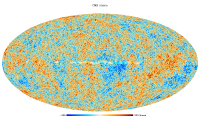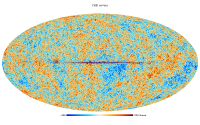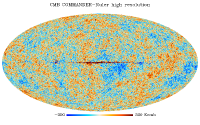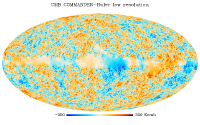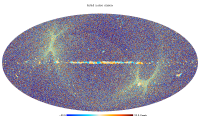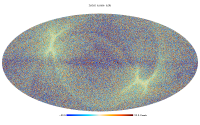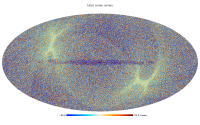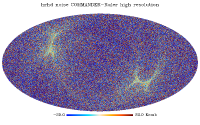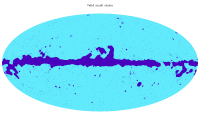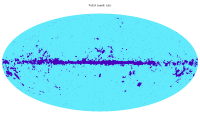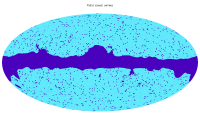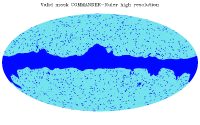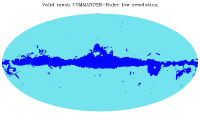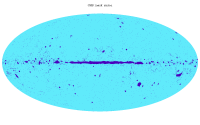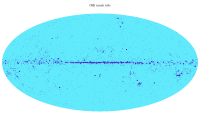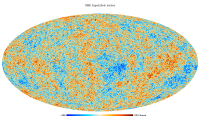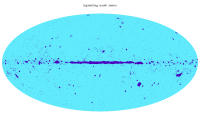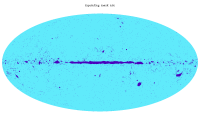Difference between revisions of "Foreground maps"
(→Thermal dust emission) |
(→2015 Compton y parameter map) |
||
| (5 intermediate revisions by the same user not shown) | |||
| Line 755: | Line 755: | ||
| − | |||
| − | '''Introduction | + | |
| + | == Thermal dust and CIB all-sky maps from GNILC component separation == | ||
| + | We describe diffuse foreground products for the Planck 2015 release produced with the GNILC component separation method. See the Planck paper {{PlanckPapers|planck2016-XLVIII}} for a detailed discussion on these products. | ||
| + | |||
| + | ===Method=== | ||
| + | |||
| + | : The basic idea behind the Generalized Needlet Internal Linear Combination (GNILC) component-separation method ([http://adsabs.harvard.edu/abs/2011MNRAS.418..467R Remazeilles et al, MNRAS 2011]) is to disentangle specific components of emission not on the sole basis of the spectral (frequency) information but also on the basis of their distinct spatial information (angular power spectrum). The GNILC method has been applied to Planck data in order to disentangle Galactic dust emission and Cosmic Infrared Background (CIB) anisotropies. Both components have a similar spectral signature but a distinct angular power spectrum (spatial signature). The spatial information used by GNILC is under the form of priors for the angular power spectra of the CIB, the CMB, and the instrumental noise. No assumption is made on the Galactic signal, neither spectral or spatial. In that sense, GNILC is a blind component-separation method. GNILC operates on a needlet (spherical wavelet) frame, therefore adapting the component separation to the local conditions of contamination both over the sky and over the angular scales. | ||
| + | |||
| + | ===Data=== | ||
| + | |||
| + | : The data used by GNILC for the analysis are the Planck data release 2 (PR2) frequency maps from 30 to 857 GHz, and a 100 micron hybrid map combined from the SFD map ([http://adsabs.harvard.edu/abs/1998ApJ...500..525S Schlegel et al, ApJ 1998]) at large angular scales (> 30') and the IRIS map ([http://adsabs.harvard.edu/abs/2005ApJS..157..302M Miville-Deschênes et al, ApJS 2005]) at small angular scales (< 30'). This special 100 micron map can be obtained in the External Maps section of the PLA. | ||
| + | |||
| + | ===Pre-processing=== | ||
| + | |||
| + | : The point-sources with a signal-to-noise ratio, S/N > 5, in each individual frequency map (30 to 857 GHz, and 100 micron) have been pre-processed by a minimum curvature surface inpainting technique ([http://adsabs.harvard.edu/abs/2015MNRAS.451.4311R Remazeilles et al, MNRAS 2015]) prior to performing component separation with GNILC. | ||
| + | |||
| + | ===GNILC thermal dust and CIB products=== | ||
| + | |||
| + | The result of GNILC component separation are thermal dust and CIB maps at 353, 545, and 857 GHz. In addition, by fitting a modified blackbody model to the GNILC thermal dust products at 353, 545, 857, and 100 micron, we have created all-sky maps of the dust optical depth, dust temperature, and dust emmissivity index. Note that the thermal dust maps have a variable angular resolution over the sky with an effective beam FWHM varying from 21.8' to 5'. The dust beam FWHM map is also released as a product. | ||
| + | |||
| + | ====Thermal dust maps==== | ||
| + | |||
| + | {| border="1" cellpadding="5" cellspacing="0" align="center" style="text-align:center" | ||
| + | |+ HDU -- COMP-MAP-DUST | ||
| + | |- | ||
| + | |- bgcolor="ffdead" | ||
| + | ! File Name || Nside || Units || Reference frequency || Angular resolution || Description | ||
| + | |- | ||
| + | |{{PLASingleFile|fileType=map|name=COM_CompMap_Dust-GNILC-F353_2048_R2.00.fits|link=COM_CompMap_Dust-GNILC-F353_2048_R2.00.fits}} || 2048 || MJy/sr || 353 GHz || {{PLASingleFile|fileType=map|name=COM_CompMap_Dust-GNILC-Beam-FWHM_0128_R2.00.fits|link=COM_CompMap_Dust-GNILC-Beam-FWHM_0128_R2.00.fits}} || Thermal dust amplitude at 353 GHz | ||
| + | |- | ||
| + | |{{PLASingleFile|fileType=map|name=COM_CompMap_Dust-GNILC-F545_2048_R2.00.fits|link=COM_CompMap_Dust-GNILC-F545_2048_R2.00.fits}} || 2048 || MJy/sr || 545 GHz || {{PLASingleFile|fileType=map|name=COM_CompMap_Dust-GNILC-Beam-FWHM_0128_R2.00.fits|link=COM_CompMap_Dust-GNILC-Beam-FWHM_0128_R2.00.fits}} || Thermal dust amplitude at 545 GHz | ||
| + | |- | ||
| + | |{{PLASingleFile|fileType=map|name=COM_CompMap_Dust-GNILC-F857_2048_R2.00.fits|link=COM_CompMap_Dust-GNILC-F857_2048_R2.00.fits}} || 2048 || MJy/sr || 857 GHz || {{PLASingleFile|fileType=map|name=COM_CompMap_Dust-GNILC-Beam-FWHM_0128_R2.00.fits|link=COM_CompMap_Dust-GNILC-Beam-FWHM_0128_R2.00.fits}} || Thermal dust amplitude at 857 GHz | ||
| + | |- | ||
| + | |{{PLASingleFile|fileType=map|name=COM_CompMap_Dust-GNILC-Model-Opacity_2048_R2.01.fits|link=COM_CompMap_Dust-GNILC-Model-Opacity_2048_R2.01.fits}} (version 2.01 includes the error map)<br>{{PLASingleFile|fileType=map|name=COM_CompMap_Dust-GNILC-Model-Opacity_2048_R2.00.fits|link=COM_CompMap_Dust-GNILC-Model-Opacity_2048_R2.00.fits}}|| 2048 || NA || 353 GHz || {{PLASingleFile|fileType=map|name=COM_CompMap_Dust-GNILC-Beam-FWHM_0128_R2.00.fits|link=COM_CompMap_Dust-GNILC-Beam-FWHM_0128_R2.00.fits}} || Thermal dust optical depth at 353 GHz | ||
| + | |- | ||
| + | |{{PLASingleFile|fileType=map|name=COM_CompMap_Dust-GNILC-Model-Spectral-Index_2048_R2.01.fits|link=COM_CompMap_Dust-GNILC-Model-Spectral-Index_2048_R2.01.fits}} (version 2.01 includes the error map)<br>{{PLASingleFile|fileType=map|name=COM_CompMap_Dust-GNILC-Model-Spectral-Index_2048_R2.00.fits|link=COM_CompMap_Dust-GNILC-Model-Spectral-Index_2048_R2.00.fits}} || 2048 || NA || NA || {{PLASingleFile|fileType=map|name=COM_CompMap_Dust-GNILC-Beam-FWHM_0128_R2.00.fits|link=COM_CompMap_Dust-GNILC-Beam-FWHM_0128_R2.00.fits}} || Thermal dust emissivity index | ||
| + | |- | ||
| + | |{{PLASingleFile|fileType=map|name=COM_CompMap_Dust-GNILC-Model-Temperature_2048_R2.01.fits|link=COM_CompMap_Dust-GNILC-Model-Temperature_2048_R2.01.fits}} (version 2.01 includes the error map)<br>{{PLASingleFile|fileType=map|name=COM_CompMap_Dust-GNILC-Model-Temperature_2048_R2.00.fits|link=COM_CompMap_Dust-GNILC-Model-Temperature_2048_R2.00.fits}} || 2048 || K || NA || {{PLASingleFile|fileType=map|name=COM_CompMap_Dust-GNILC-Beam-FWHM_0128_R2.00.fits|link=COM_CompMap_Dust-GNILC-Beam-FWHM_0128_R2.00.fits}} || Thermal dust temperature | ||
| + | |- | ||
| + | |{{PLASingleFile|fileType=map|name=COM_CompMap_Dust-GNILC-Radiance_2048_R2.00.fits|link=COM_CompMap_Dust-GNILC-Radiance_2048_R2.00.fits}} || 2048 || W/m<sup>2</sup>/sr || NA || {{PLASingleFile|fileType=map|name=COM_CompMap_Dust-GNILC-Beam-FWHM_0128_R2.00.fits|link=COM_CompMap_Dust-GNILC-Beam-FWHM_0128_R2.00.fits}} || Thermal dust radiance | ||
| + | |- | ||
| + | | {{PLASingleFile|fileType=map|name=COM_CompMap_Dust-GNILC-Beam-FWHM_0128_R2.00.fits|link=COM_CompMap_Dust-GNILC-Beam-FWHM_0128_R2.00.fits}} || 128 || Arcminute || NA || NA || Effective dust beam FWHM | ||
| + | |- | ||
| + | |} | ||
| + | |||
| + | ====CIB maps==== | ||
| + | |||
| + | |||
| + | {| border="1" cellpadding="5" cellspacing="0" align="center" style="text-align:center" | ||
| + | |+ HDU -- COMP-MAP-CIB | ||
| + | |- | ||
| + | |- bgcolor="ffdead" | ||
| + | ! File Name || Nside || Units || Reference frequency || Angular resolution || Description | ||
| + | |- | ||
| + | |{{PLASingleFile|fileType=map|name=COM_CompMap_CIB-GNILC-F353_2048_R2.00.fits|link=COM_CompMap_CIB-GNILC-F353_2048_R2.00.fits}} || 2048 || MJy/sr || 353 GHz || 5 arcmin || CIB amplitude at 353 GHz | ||
| + | |- | ||
| + | |{{PLASingleFile|fileType=map|name=COM_CompMap_CIB-GNILC-F545_2048_R2.00.fits|link=COM_CompMap_CIB-GNILC-F545_2048_R2.00.fits}} || 2048 || MJy/sr || 545 GHz || 5 arcmin || CIB amplitude at 545 GHz | ||
| + | |- | ||
| + | |{{PLASingleFile|fileType=map|name=COM_CompMap_CIB-GNILC-F857_2048_R2.00.fits|link=COM_CompMap_CIB-GNILC-F857_2048_R2.00.fits}} || 2048 || MJy/sr || 857 GHz || 5 arcmin || CIB amplitude at 857 GHz | ||
| + | |- | ||
| + | |} | ||
| + | |||
| + | |||
| + | == Other Special maps == | ||
| + | |||
| + | ===Introduction=== | ||
This section describes the map-based products that required special processing. | This section describes the map-based products that required special processing. | ||
| − | + | === 2015 Compton <i>y</i> parameter map === | |
| − | We distribute here the Planck full mission Compton parameter maps (<i>y</i>-maps hereafter) obtained using the NILC and MILCA component-separation algorithms as described in {{PlanckPapers|planck2014-a28}}. We also provide the ILC weights per scale and per frequency that were used to produce these <i>y</i>-maps. IDL routines are also provided to allow the user to apply those weights. Compton parameters produced by keeping either the first or the second half of stable pointing periods are also provided; we call these the FIRST and LAST <i>y</i>-maps. Additionally we construct noise estimates of full mission Planck <i>y</i>-maps from the half difference of the FIRST and LAST <i>y</i>-maps. These estimates are used to construct standard deviation maps of the noise in the full mission Planck <i>y</i>-maps, which are also provided. To complement this we also provide the power spectra of the noise estimate maps after correcting for inhomogeneities using the standard deviation maps. We also deliver foreground masks including point-source and Galactic masks. | + | We distribute here the Planck full mission Compton parameter maps (<i>y</i>-maps hereafter) obtained using the NILC and MILCA component-separation algorithms as described in {{PlanckPapers|planck2014-a28}}. We also provide the ILC weights per scale and per frequency that were used to produce these <i>y</i>-maps. IDL routines are also provided to allow the user to apply those weights [[:File: milca_nilc_IDL_routines.zip]]. Compton parameters produced by keeping either the first or the second half of stable pointing periods are also provided; we call these the FIRST and LAST <i>y</i>-maps. Additionally we construct noise estimates of full mission Planck <i>y</i>-maps from the half difference of the FIRST and LAST <i>y</i>-maps. These estimates are used to construct standard deviation maps of the noise in the full mission Planck <i>y</i>-maps, which are also provided. To complement this we also provide the power spectra of the noise estimate maps after correcting for inhomogeneities using the standard deviation maps. We also deliver foreground masks including point-source and Galactic masks. |
<span style="color:#ff0000"> Update 04 Aug 2017:</span> The file containing the masks named ''COM_CompMap_Compton-SZMap-masks_2048_R2.00.fits'' has been updated with the file ''COM_CompMap_Compton-SZMap-masks_2048_R2.01.fits''. The difference between the two is that in the R2.00 version a region around the Galactic pole had been masked, while only the Galactic plane should be masked. This has been fixed in version R2.01. The full updated data set is contained in a single gzipped tarball named ''COM_CompMap_YSZ_R2.01.fits.tgz''. The R2.00 version of the mask is not available in the PLA anymore, but can be requested via the PLA Helpdesk. | <span style="color:#ff0000"> Update 04 Aug 2017:</span> The file containing the masks named ''COM_CompMap_Compton-SZMap-masks_2048_R2.00.fits'' has been updated with the file ''COM_CompMap_Compton-SZMap-masks_2048_R2.01.fits''. The difference between the two is that in the R2.00 version a region around the Galactic pole had been masked, while only the Galactic plane should be masked. This has been fixed in version R2.01. The full updated data set is contained in a single gzipped tarball named ''COM_CompMap_YSZ_R2.01.fits.tgz''. The R2.00 version of the mask is not available in the PLA anymore, but can be requested via the PLA Helpdesk. | ||
| − | <span style="color:#ff0000"> Update 30 July 2018:</span> The angular power spectra homogeneous noise files nilc_homnoise_spect.fits and milca_homnoise_spect.fits in COM_CompMap_YSZ_R2.01.fits.tgz have been updated. A new version of the | + | <span style="color:#ff0000"> Update 30 July 2018:</span> The angular power spectra homogeneous noise files nilc_homnoise_spect.fits and milca_homnoise_spect.fits in COM_CompMap_YSZ_R2.01.fits.tgz have been updated. A new version of the COM_CompMap_SZ_R2.02.fits.tgz package is available in the PLA. |
The contents of the full data set are described below. | The contents of the full data set are described below. | ||
| Line 798: | Line 863: | ||
|} | |} | ||
| − | + | === 2015 Integrated Sachs-Wolfe effect map === | |
| − | |||
| − | |||
We distribute estimates of the integrated Sachs-Wolfe (ISW) maps presented in {{PlanckPapers|planck2014-a26}} as part of the 2015 data release. These map represents an estimate of the ISW anisotropies using different data sets: | We distribute estimates of the integrated Sachs-Wolfe (ISW) maps presented in {{PlanckPapers|planck2014-a26}} as part of the 2015 data release. These map represents an estimate of the ISW anisotropies using different data sets: | ||
| Line 826: | Line 889: | ||
| − | + | === 2015 Low-frequency foregrounds maps (Planck only & Planck+WMAP) === | |
1) CMB/free-free/Dust Nulled ILC at 28.4 GHz (Planck only) | 1) CMB/free-free/Dust Nulled ILC at 28.4 GHz (Planck only) | ||
Latest revision as of 17:33, 22 October 2021
Contents
[hide]- 1 2018 Astrophysical Components
- 2 Previous Releases: (2015) and (2013) Foreground Maps
- 3 References
2018 Astrophysical Components[edit]
Overview[edit]
This section describes the maps of astrophysical components produced from the Planck data. These products are derived from some or all of the nine frequency channel maps described above using different techniques and, in some cases, using other constraints from external data sets. Here we give a brief description of each product and how it is obtained, followed by a description of the FITS file containing the data and associated information. All the details can be found in Planck-2020-A4[1] and Planck-2020-A8[2].
Commander-derived astrophysical foreground maps[edit]
As discussed in detail in Planck-2020-A4[1], the main Planck 2018 frequency sky maps have significantly lower systematic errors than earlier versions. At the same time, these maps are also associated with a significant limitation, in that no robust single detector or detector set maps are available. As described in Planck-2020-A3[3], such maps do not contain the full signal content of the true sky. As a result, only full frequency maps are distributed and used in the 2018 analysis.
For polarization analysis, this is not a significant issue, and the 2018 polarization foreground products therefore supersede the 2015 release in all respects. However, for temperature analysis the lack of single-detector maps strongly limits the ability to extract CO line emission from the data set, and it is also not possible to exclude known detector outliers; see Planck-2015-A10[4] for details. For these reasons, we consider the parametric foreground products from 2015 to represent a more accurate description of the true sky than the corresponding 2018 version. As a result, we do not release parametric temperature foreground products from the 2018 data set, but rather recommend continued usage of the 2015 temperature model. For polarization, we recommend usage of the 2018 model.
Two Commander-based polarization foreground products are provided for the Planck 2018 releaes, namely synchrotron and thermal dust emission. For synchrotron emission, a spatially constant spectral index of β=-3.1 is adopted. For thermal dust emission, the dust temperature is fixed to that derived from the corresponding 2018 intensity analysis, while the spectral index is fitted directly from the polarization measurements, smoothed to 3 degrees FWHM. For both synchrotron and thermal dust emission, we provide results derived from both the full-mission data set, and from the half-mission and odd-even splits.
In addition to the real observations, we also provide 300 end-to-end noise simulations processed through the algorithm with the same spectral parameters as derived from the data for each of the data splits. The filenames of these simulations have the following format:
- dx12_v3_commander_{synch,dust}_noise_{full,hm1,hm2,oe1,oe2}_00???_raw.fits
Inputs[edit]
The following data products are used for the full-mission polarization analysis (corresponding data are used for the data split products):
- Full-mission 30 GHz frequency map, LFI 30 GHz frequency maps
- Full-mission 44 GHz frequency map, LFI 44 GHz frequency maps
- Full-mission 70 GHz frequency map, LFI 70 GHz frequency maps
- Full-mission 100 GHz frequency map, HFI 100 GHz frequency maps
- Full-mission 143 GHz frequency map, HFI 143 GHz frequency maps
- Full-mission 217 GHz frequency map, HFI 217 GHz frequency maps
- Full-mission 353 GHz frequency map, HFI 353 GHz frequency maps
Outputs[edit]
Synchrotron emission[edit]
- Full-mission file name: COM_CompMap_QU_synchrotron-commander_2048_R3.00_full.fits
- First half-mission split file name: COM_CompMap_QU_synchrotron-commander_2048_R3.00_hm1.fits
- Second half-mission split file name: COM_CompMap_QU_synchrotron-commander_2048_R3.00_hm2.fits
- Odd ring split file name: COM_CompMap_QU_synchrotron-commander_2048_R3.00_oe1.fits
- Even ring split file name: COM_CompMap_QU_synchrotron-commander_2048_R3.00_oe2.fits
- Nside = 2048
- Angular resolution = 40 arcmin
- Reference frequency: 30 GHz
| Column Name | Data Type | Units | Description |
|---|---|---|---|
| Q_STOKES | Real*4 | μK_RJ | Stokes Q posterior maximum |
| U_STOKES | Real*4 | μK_RJ | Stokes U posterior maximum |
Thermal dust emission[edit]
- Full-mission file name: COM_CompMap_QU_thermaldust-commander_2048_R3.00_full.fits
- First half-mission split file name: COM_CompMap_QU_thermaldust-commander_2048_R3.00_hm1.fits
- Second half-mission split file name: COM_CompMap_QU_thermaldust-commander_2048_R3.00_hm2.fits
- Odd ring split file name: COM_CompMap_QU_thermaldust-commander_2048_R3.00_oe1.fits
- Even ring split file name: COM_CompMap_QU_thermaldust-commander_2048_R3.00_oe2.fits
- Nside = 2048
- Angular resolution = 5 arcmin
- Reference frequency: 353 GHz
| Column Name | Data Type | Units | Description |
|---|---|---|---|
| Q_STOKES | Real*4 | uK_RJ | Full-mission Stokes Q posterior maximum |
| U_STOKES | Real*4 | uK_RJ | Full-mission Stokes U posterior maximum |
| BETA | Real*4 | Spectral index (full mission only) |
SMICA-derived astrophysical foreground maps[edit]
Two SMICA-based polarization foreground products are provided, namely synchrotron and thermal dust emission. These are derived using the usual SMICA spectral matching method, tuned specifically for the reconstruction of two polarized foregrounds. Specifically, three coherent components (plus noise) are fitted at the spectral level with the first one constrained to have CMB emissivity. No assumptions are made regarding the other two components: they are not assumed to have a specific emissivity or angular spectrum, nor are they assumed to be uncorrelated. This leaves a degenerate model but that degeneracy can be entirely fixed after the spectral fit by assuming that synchrotron emission is negligible at 353 GHz and that thermal dust emission is negligible at 30 GHz. For both synchrotron and thermal dust emission, we provide results derived from both the full-mission data set, and from the half-mission and odd-even splits.
In addition to the real observations, we also provide 300 end-to-end noise simulations processed through the algorithm with the same spectral parameters as derived from the data for each of the data splits. The filenames of these simulations have the following format:
- dx12_v3_smica_{synch,dust}_noise_{full,hm1,hm2,oe1,oe2}_00???_raw.fits
Inputs[edit]
The following data products are used for the full-mission polarization analysis (corresponding data are used for the data split products):
- Full-mission 30 GHz frequency map, LFI 30 GHz frequency maps
- Full-mission 44 GHz frequency map, LFI 44 GHz frequency maps
- Full-mission 70 GHz frequency map, LFI 70 GHz frequency maps
- Full-mission 100 GHz frequency map, HFI 100 GHz frequency maps
- Full-mission 143 GHz frequency map, HFI 143 GHz frequency maps
- Full-mission 217 GHz frequency map, HFI 217 GHz frequency maps
- Full-mission 353 GHz frequency map, HFI 353 GHz frequency maps
Outputs[edit]
Synchrotron emission[edit]
- Full-mission file name: COM_CompMap_QU_synchrotron-smica_2048_R3.00_full.fits
- First half-mission split file name: COM_CompMap_QU_synchrotron-smica_2048_R3.00_hm1.fits
- Second half-mission split file name: COM_CompMap_QU_synchrotron-smica_2048_R3.00_hm2.fits
- Odd ring split file name: COM_CompMap_QU_synchrotron-smica_2048_R3.00_oe1.fits
- Even ring split file name: COM_CompMap_QU_synchrotron-smica_2048_R3.00_oe2.fits
- Nside = 2048
- Angular resolution = 40 arcmin
- Reference frequency: Integrated 30 GHz band; no colour corrections have been applied
| Column Name | Data Type | Units | Description |
|---|---|---|---|
| Q_STOKES | Real*4 | mK_RJ | Stokes Q posterior maximum |
| U_STOKES | Real*4 | mK_RJ | Stokes U posterior maximum |
Thermal dust emission[edit]
- Full-mission file name: COM_CompMap_QU_thermaldust-smica_2048_R3.00_full.fits
- First half-mission split file name: COM_CompMap_QU_thermaldust-smica_2048_R3.00_hm1.fits
- Second half-mission split file name: COM_CompMap_QU_thermaldust-smica_2048_R3.00_hm2.fits
- Odd ring split file name: COM_CompMap_QU_thermaldust-smica_2048_R3.00_oe1.fits
- Even ring split file name: COM_CompMap_QU_thermaldust-smica_2048_R3.00_oe2.fits
- Nside = 2048
- Angular resolution = 12 arcmin
- Reference frequency: Integrated 353 GHz band; no colour corrections have been applied
| Column Name | Data Type | Units | Description |
|---|---|---|---|
| Q_STOKES | Real*4 | mK_RJ | Full-mission Stokes Q posterior maximum |
| U_STOKES | Real*4 | mK_RJ | Full-mission Stokes U posterior maximum |
GNILC thermal dust maps[edit]
The 2018 GNILC thermal dust products are provided as single files that include both intensity and polarization, 3x3 IQU noise covariance matrices per pixel, and as well as local smoothing scale for the variable resolution map. The structure of the data files is the following:
- Uniform resolution file name: COM_CompMap_IQU_thermaldust-gnilc-unires_2048_R3.00.fits
- Variable resolution file name: COM_CompMap_IQU_thermaldust-gnilc-varres_2048_R3.00.fits
- Nside = 2048
- Angular resolution = 80 arcmin FWHM, or variable
- Reference frequency: Integrated 353 GHz band; no colour corrections have been applied
| Column Name | Data Type | Units | Description |
|---|---|---|---|
| I_STOKES | Real*4 | K_cmb | Stokes I estimate |
| Q_STOKES | Real*4 | K_cmb | Stokes Q estimate |
| U_STOKES | Real*4 | K_cmb | Stokes U estimate |
| II_COV | Real*4 | K_cmb^2 | Covariance matrix II element |
| IQ_COV | Real*4 | K_cmb^2 | Covariance matrix IQ element |
| IU_COV | Real*4 | K_cmb^2 | Covariance matrix IU element |
| QQ_COV | Real*4 | K_cmb^2 | Covariance matrix QQ element |
| QU_COV | Real*4 | K_cmb^2 | Covariance matrix QU element |
| UU_COV | Real*4 | K_cmb^2 | Covariance matrix UU element |
| FWHM | Real*4 | arcmin | Local FWHM smoothing scale |
Previous Releases: (2015) and (2013) Foreground Maps[edit]
Astrophysical components based on the 2015 data release
Astrophysical components based on the 2013 data release
References[edit]
- ↑ Jump up to: 1.01.1 Planck 2018 results. IV. Diffuse component separation, Planck Collaboration, 2020, A&A, 641, A4.
- Jump up ↑ Planck 2018 results. VIII. Lensing, Planck Collaboration, 2020, A&A, 641, A8.
- Jump up ↑ Planck 2018 results. III. High Frequency Instrument data processing and frequency maps, Planck Collaboration, 2020, A&A, 641, A3.
- ↑ Jump up to: 4.04.14.2 Planck 2015 results. X. Diffuse component separation: Foreground maps, Planck Collaboration, 2016, A&A, 594, A10.
- ↑ Jump up to: 5.05.15.25.3 Planck 2015 results. XXV. Diffuse low frequency Galactic foregrounds, Planck Collaboration, 2016, A&A, 594, A25.
- Jump up ↑ Planck intermediate results. XXIX. All-sky dust modelling with Planck, IRAS, and WISE observations', Planck Collaboration Int. XXIX, A&A, 586, A132, (2016).
- Jump up ↑ Planck intermediate results. XLVIII. Disentangling Galactic dust emission and cosmic infrared background anisotropies, Planck Collaboration Int. XLVIII A&A, 596, A109, (2016).
- Jump up ↑ Planck 2015 results. XXII. A map of the thermal Sunyaev-Zeldovich effect, Planck Collaboration, 2016, A&A, 594, A22.
- Jump up ↑ Planck 2015 results. XXI. The integrated Sachs-Wolfe effect, Planck Collaboration, 2016, A&A, 594, A21.
- ↑ Jump up to: 10.010.110.210.310.410.510.610.7 Planck 2013 results. XI. Component separation, Planck Collaboration, 2014, A&A, 571, A11.
- Jump up ↑ Component separation methods for the PLANCK mission, S. M. Leach, J.-F. Cardoso, C. Baccigalupi, R. B. Barreiro, M. Betoule, J. Bobin, A. Bonaldi, J. Delabrouille, G. de Zotti, C. Dickinson, H. K. Eriksen, J. González-Nuevo, F. K. Hansen, D. Herranz, M. Le Jeune, M. López-Caniego, E. Martínez-González, M. Massardi, J.-B. Melin, M.-A. Miville-Deschênes, G. Patanchon, S. Prunet, S. Ricciardi, E. Salerno, J. L. Sanz, J.-L. Starck, F. Stivoli, V. Stolyarov, R. Stompor, P. Vielva, A&A, 491, 597-615, (2008).
- Jump up ↑ Multiresolution internal template cleaning: an application to the Wilkinson Microwave Anisotropy Probe 7-yr polarization data, R. Fernández-Cobos, P. Vielva, R. B. Barreiro, E. Martínez-González, MNRAS, 420, 2162-2169, (2012).
- Jump up ↑ Wilkinson Microwave Anisotropy Probe 7-yr constraints on fNL with a fast wavelet estimator, B. Casaponsa, R. B. Barreiro, A. Curto, E. Martínez-González, P. Vielva, MNRAS, 411, 2019-2025, (2011).
- ↑ Jump up to: 14.014.1 Planck 2013 results. XXIII. Isotropy and statistics of the CMB, Planck Collaboration, 2014, A&A, 571, A23.
- ↑ Jump up to: 15.015.1 Planck 2013 results. XIX. The integrated Sachs-Wolfe effect, Planck Collaboration, 2014, A&A, 571, A19.
- ↑ Jump up to: 16.016.1 Planck 2013 results. XII. All-sky model of thermal dust emission, Planck Collaboration, 2014, A&A, 571, A12.
- Jump up ↑ Calibrating Milky Way dust extinction using cosmological sources, E. Mörtsell, A&A, 550, A80, (2013).
- Jump up ↑ The Sloan Digital Sky Survey Quasar Catalog. IV. Fifth Data Release, D. P. Schneider, P. B. Hall, G. T. Richards, M. A. Strauss, D. E. Vanden Berk, S. F. Anderson, W. N. Brandt, X. Fan, S. Jester, J. Gray, J. E. Gunn, M. U. SubbaRao, A. R. Thakar, C. Stoughton, A. S. Szalay, B. Yanny, D. G. York, N. A. Bahcall, J. Barentine, M. R. Blanton, H. Brewington, J. Brinkmann, R. J. Brunner, F. J. Castander, I. Csabai, J. A. Frieman, M. Fukugita, M. Harvanek, D. W. Hogg, Z. Ivezic, S. M. Kent, S. J. Kleinman, G. R. Knapp, R. G. Kron, J. Krzesinski, D. C. Long, R. H. Lupton, A. Nitta, J. R. Pier, D. H. Saxe, Y. Shen, S. A. Snedden, D. H. Weinberg, J. Wu, ApJ, 134, 102-117, (2007).
- Jump up ↑ Planck 2013 results. XIII. Galactic CO emission, Planck Collaboration, 2014, A&A, 571, A13.
Flexible Image Transfer Specification
Full-Width-at-Half-Maximum
Cosmic Microwave background
Sunyaev-Zel'dovich
Planck Legacy Archive
(Hierarchical Equal Area isoLatitude Pixelation of a sphere, <ref name="Template:Gorski2005">HEALPix: A Framework for High-Resolution Discretization and Fast Analysis of Data Distributed on the Sphere, K. M. Górski, E. Hivon, A. J. Banday, B. D. Wandelt, F. K. Hansen, M. Reinecke, M. Bartelmann, ApJ, 622, 759-771, (2005).
(Planck) Low Frequency Instrument
(Planck) High Frequency Instrument
reduced IMO
